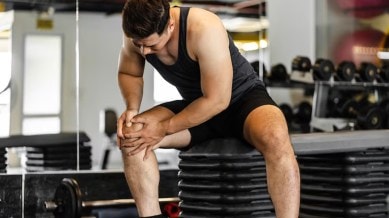📣 For more lifestyle news, click here to join our WhatsApp Channel and also follow us on Instagram
Eight common gym mistakes that can wreck your joints before 30: ‘Some lifts build muscle, others build hospital visits’
Trainer explains how bad form and ego lifting can destroy your joints

You might think that hitting the gym daily and pushing yourself harder with every session is a sign of discipline and progress. But doing it wrong can silently sabotage your body.
He breaks down specific exercises that might feel powerful or look impressive but are silently harmful. For example, Alex explains that upright rows may feel great initially, “until your shoulders start clicking every time you reach overhead,” because that internal rotation under load “is a recipe for disaster.” Similarly, he cautions against doing the bench press with flared elbows, saying, “Stop flaring your elbows out like a chicken. You’re not hitting more chest, you’re tearing up your shoulders. Tuck your elbows, set your back, and control the damn bar.”
Even certain ‘advanced’ moves are riskier than most people realise. The behind-the-neck press, Alex says, offers “no real benefits at all,” adding, “Your shoulders aren’t meant to move that way. Keep the bar in front and you’ll actually be able to lift long-term.” The same goes for Smith machine squats, which, while appearing stable, “put serious strain on your knees,” as “that fixed bar path might look clean, but your knees hate you for it.”
Alex also criticises ego-driven moves like heavy good mornings and shrugs, and poor form during pull-ups and leg presses. “You’re not ‘feeling your hamstrings’. You’re rounding your spine and praying it doesn’t pop,” he says about the former. On kipping pull-ups, he remarks, “You’re not doing pull-ups, you’re just fighting gravity with terrible form.” And on people using their arms during leg press reps, he quips, “If you need to use your arms to finish a leg press rep, your weights are far too heavy.”
But what actually happens to the joints when these exercises are performed incorrectly?
Sadhna Singh, senior fitness and lifestyle consultant at HereNow Official, tells indianexpress.com, “When these movements are done incorrectly, they force the shoulder into extreme internal rotation, which compresses the rotator cuff tendons and irritates the shoulder joint capsule. Over time, this can lead to impingement or even small tears that become chronic pain issues.”
She suggests that a safer way to build similar strength is to do lateral raises, front raises, or standard overhead presses, where the shoulder moves in a more natural range of motion. The goal should be to strengthen through alignment, not by forcing the joint into angles it’s not designed for.
Why is elbow positioning so crucial in pressing movements?
Elbow positioning directly determines how the shoulder joint bears load. When elbows flare out, the upper arm rotates internally, which puts unnecessary stress on the shoulder capsule and pectoral tendon. “By keeping the elbows tucked slightly inward, you allow the shoulder blades to move freely and stabilise the lift better,” notes Singh.
How can someone differentiate between a challenging but safe workout and one that’s causing cumulative joint stress?
A workout should challenge the muscle, not the joint. The difference lies in the type of discomfort you feel; muscular fatigue feels like a burn that eases with rest, while joint stress feels sharp, deep, or lingers the next day.
“The mistake many make is confusing ‘no pain, no gain’ with progress. Cumulative joint stress often builds silently through poor alignment and ego lifting. To prevent that, focus on controlled movement, steady tempo, and quality over quantity. Your joints should feel stable, not sore, after a good session,” concludes Singh.
📣 For more lifestyle news, click here to join our WhatsApp Channel and also follow us on Instagram